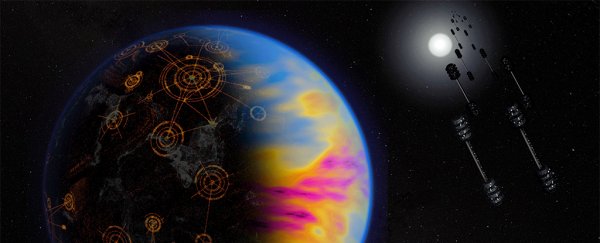The Universe is a big place, so scientists are keen to narrow down their search for alien life – maybe by looking for radio signals, or hospitable climates, or huge megastructures. Now another sign of alien life is under consideration: atmospheric pollution.
If there are alien civilisations out there, the hypothesis goes, then their activities and industries may have produced pollution just like ours have. That pollution could be something we could spot in our scans of deep space.
A new study suggests nitrogen dioxide gas (NO2) could indicate life on other planets: It can be produced from burning fossil fuels, as well as from lighting, volcanoes, and other biological, non-industrial sources.
"On Earth, most of the nitrogen dioxide is emitted from human activity – combustion processes such as vehicle emissions and fossil-fuelled power plants," says astrobiologist Ravi Kopparapu, from the NASA Goddard Space Flight Center.
"Observing NO2 on a habitable planet could potentially indicate the presence of an industrialised civilisation."
The presence of NO2 would be called a technosignature – a sign of technology on an exoplanet outside our Solar System. While these planets are too far away to send probes to, we can study them through our increasingly powerful telescopes.
This new study doesn't involve any observing, but the researchers have used computer models to crunch the numbers on what a NO2 technosignature would look like, and whether or not our telescopes would be able to see it based on how nitrogen dioxide absorbs and reflects light.
The researchers found that large telescope like the James Webb Space Telescope would need around 400 hours of observing time at a distance of 30 light-years to spot an Earth-like planet near a Sun-like star – one that was producing about as much NO2 as we are on our planet. That's a long observation shift, but not outside the bounds of possibility.
The team also suggests that NO2 would be a better technosignature than chlorofluorocarbons (CFCs), which have been considered before; CFCs don't occur in nature so they're less likely to fool us compared to NO2, but they might not be a common enough indicator for us to look for.
"As far as we know, CFCs are not produced by biology at all, so they are a more obvious technosignature than NO2," says astrobiologist Jacob Haqq-Misra from the Blue Marble Institute of Science.
"However, CFCs are very specific manufactured chemicals that might not be prevalent elsewhere; NO2, by comparison, is a general byproduct of any combustion process."
During the course of their calculations, the researchers found that K and M-type stars – cooler and more common than our Sun – would give off a stronger, more easily detected NO2 signal, because they produce less interfering ultraviolet light.
With more than 4,000 exoplanets discovered over the past 25 years, astronomers have plenty of options to explore, and any reliable method that can be used to identify the most likely locations for alien civilisations is going to be helpful.
However, interpreting light reflections and the resulting data over so great a distance isn't an easy task, and we're going to need more advanced models further down the line – models that can factor in the presence of clouds or aerosols in the atmosphere, for example, which can mimic the NO2 technosignature.
"If we observe more NO2 than our models suggest is plausible from non-industrial sources, then the rest of the NO2 might be attributed to industrial activity," says astrobiologist Giada Arney from NASA Goddard.
"Yet there is always a possibility of a false positive in the search for life beyond Earth, and future work will be needed to ensure confidence in distinguishing true positives from false positives."
The research has been accepted for the Astrophysical Journal and published online at arXiv.org.
